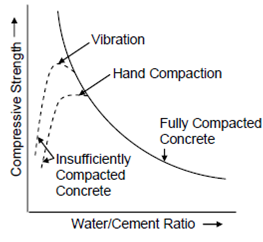Abrams' Water Cement Ratio Law:
Duff Abrams established the W/C ratio law, which correlates the strength of concrete to the W/C ratio. It says in which, "with the given concrete ingredients and test conditions, an quantity of mixing water used alone determines the strength of concrete, so long as the concrete mix is workable." In other words the law states that strength of concrete only depends upon W/C ratio provided the mix is workable. The limitation of the Abrams' law is that the effect of entrapped air on strength of concrete is ignored, whereas the strength of concrete is greatly effected by the presence of entrapped air. For example, 5 percent of voids can lower the strength by as much as 35 percent and even 2 percent of voids can reduce the strength of concrete by more than 10 percent. On the basis of various test results the above law can be numerically stated as
S = A /B x
where, S = 28 days' compressive strength of concrete; A and B are two imperical constants and x is water cement ratio.

Figure: Relation between Strength and Water Cement Ratio
A typical plot of this equation is shown in Figure 1. It can be observed from the plot that:
(a) The Strength of concrete is inversely proportional to the W/C ratio.
(b) For achieving the similar strength higher W/C ratio is required for hand compacted concrete as compared to that required for vibrated concrete.
(c) At extremely low W/C ratio this law ceases, as at such low W/C ratio compaction is not possible.